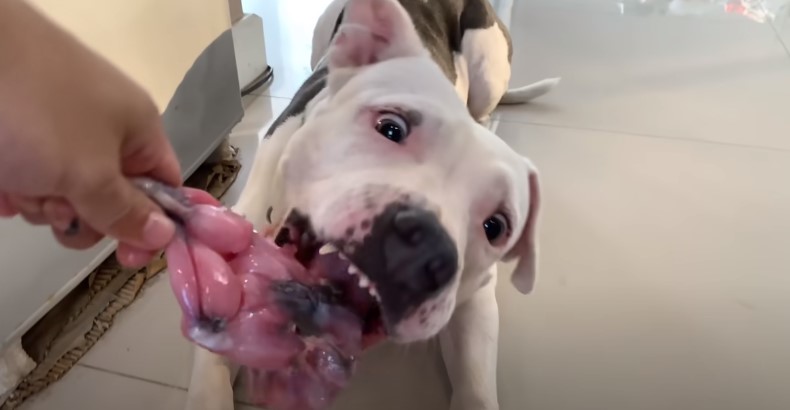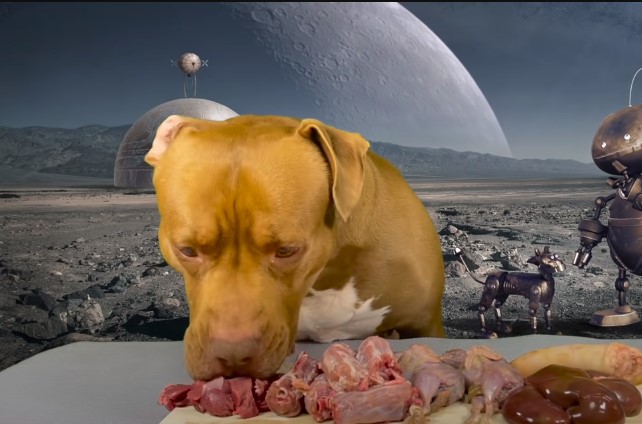In understanding the financial aspects of raw feeding for dogs, clarity is key. Calculating the cost involves evaluating factors like a dog’s size, dietary needs, and sourcing ingredients.
Let’s delve into each aspect to provide a comprehensive overview of how much it truly costs to raw feed your canine companion.
How Much Does It Cost to Raw Feed a Dog?
Opting for commercially prepared frozen or freeze-dried raw dog food typically amounts to about $12 per day and around $353 monthly on average. Remember, costs can differ based on the chosen supplier.
On the other hand, crafting a homemade raw diet varies according to your veterinarian’s recommendations, introducing a potential range of expenses.
What is a Raw Dog Diet?
A raw dog diet, also known as a raw food diet or a raw feeding diet, involves providing dogs with uncooked and unprocessed foods similar to what they might eat in the wild.

This diet typically consists of raw meat, bones, organs, and sometimes vegetables or fruits. Advocates believe it’s a more natural and biologically appropriate way to feed dogs, though proper balance and nutritional guidelines are essential.
What Are the Pros and Cons of a Raw Dog Diet?
As the debate over the best diet for dogs continues, the raw dog diet has gained popularity among pet owners seeking a more natural approach to canine nutrition.
This diet aims to mimic a dog’s ancestral diet by offering raw, unprocessed foods. However, like any dietary choice, there are both advantages and disadvantages to consider.
Pros of a Raw Dog Diet
Biologically Appropriate
Advocates argue that raw diets mirror what dogs would consume in the wild, potentially promoting better digestion and overall health due to a diet more aligned with their evolutionary needs.
Improved Coat and Skin
Many supporters of raw feeding report that their dogs develop shinier coats and healthier skin. This could be attributed to the higher levels of Omega-3 fatty acids and other nutrients found in raw meats.

Dental Health
Chewing on raw meaty bones can help naturally clean a dog’s teeth, reducing the risk of dental problems and promoting better oral hygiene.
Allergies and Sensitivities
Some dogs with food allergies or sensitivities might find relief in a raw diet, as it eliminates common allergens found in commercial kibble.
Weight Management
A well-balanced raw diet allows for precise control over a dog’s nutrient intake, making it easier to manage their weight.
Higher Energy Levels
Advocates often claim that dogs on a raw diet exhibit increased energy and vitality, which could be attributed to the diet’s nutrient-rich nature.
Reduced Filler Ingredients
Commercial dog foods often contain fillers and additives; a raw diet eliminates these, potentially reducing the risk of digestive issues.

Cons of a Raw Dog Diet
Nutritional Imbalance
Creating a balanced raw diet requires meticulous planning. Inadequate nutrition can lead to deficiencies or excesses of certain nutrients, potentially harming a dog’s health.
Risk of Bacterial Contamination
Raw meat can harbor harmful bacteria like Salmonella and E. coli, posing a risk to both dogs and their human caregivers. Safe food handling and storage practices are crucial.
Bone Hazards
While bones can benefit dental health, they can also pose a choking hazard or cause internal injuries if not chosen and prepared correctly.
Expense and Time
Sourcing high-quality ingredients and preparing raw meals can be costly and time-consuming compared to commercial dog food options.
Veterinary Oversight
A raw diet demands regular monitoring by a veterinarian to ensure it meets a dog’s specific nutritional requirements. This can incur additional expenses.

Potential Digestive Upset
Abruptly transitioning a dog to a raw diet can lead to digestive issues like diarrhea or vomiting. Gradual transitions are recommended.
Zoonotic Concerns
Handling raw meat increases the risk of zoonotic disease transmission from pets to humans, emphasizing the importance of safe food handling practices.
What Are the Factors Affecting costs of Raw Feeding a Dog?
Raw feeding for dogs is a dietary approach that offers both benefits and challenges. One crucial aspect to consider is the cost, which can vary significantly depending on a range of factors.
Understanding these factors can help dog owners make informed decisions about whether raw feeding is financially feasible for their furry companions.

Dog’s Size and Nutritional Needs
The size of a dog directly impacts the amount of food they require. Larger dogs consume more, thus increasing the overall cost. Puppies and active dogs also have higher energy needs, affecting portion sizes and ingredient quantities.
Ingredient Selection
The quality and variety of ingredients in a raw diet influence both nutritional value and cost. Premium meats and organic produce are pricier than conventional options.
Balancing the diet with appropriate ratios of muscle meat, organ meat, bones, and supplements further contributes to the overall expense.
Sourcing and Suppliers
The cost of raw feeding is influenced by where ingredients are sourced. Buying directly from farmers or butchers might be more cost-effective than purchasing from specialty pet stores.
Comparing prices across different suppliers is crucial to finding the most economical options.

Homemade Versus Premade Diets
Choosing between homemade raw diets and pre-made commercial raw food significantly impacts costs. Homemade diets allow for more control over ingredient selection but can require more effort in meal preparation.
Commercial diets offer convenience, but their prices can vary widely based on brand and quality.
Local Cost of Living
The cost of ingredients can be influenced by the local cost of living. Ingredients might be more expensive in urban areas compared to rural regions, impacting the overall cost of raw feeding.
Supplements and Additives
Supplements like vitamins, minerals, and essential fatty acids might be necessary to ensure a dog’s nutritional needs are met. These additional costs should be factored into the overall expense of raw feeding.

Storage and Freezer Space
Raw feeding often involves buying ingredients in bulk, requiring adequate freezer space for storage. Investing in a suitable freezer and managing storage space can affect the upfront cost of adopting a raw diet.
Transition and Veterinary Care
The transition to a raw diet should be gradual to prevent digestive upset. This might involve purchasing smaller amounts of ingredients initially. Additionally, regular veterinary check-ups are crucial to monitor the dog’s health and dietary needs, adding to the overall cost.
Time and Effort
Preparing homemade raw meals demands time and effort. From sourcing ingredients to preparing and portioning meals, the investment of time can indirectly affect the overall cost.
Potential Health Savings
While raw feeding can be expensive upfront, some proponents argue that it might lead to fewer health issues in the long run, potentially reducing veterinary costs associated with chronic conditions [1] often linked to processed diets.
Conclusion
In gauging the cost of raw feeding for dogs, practicality prevails. Factors like dog size, ingredient quality, and meal preparation impact expenses. Balancing nutritional value against budget considerations ensures an informed decision aligning with both your pet’s well-being and your financial capacity.

